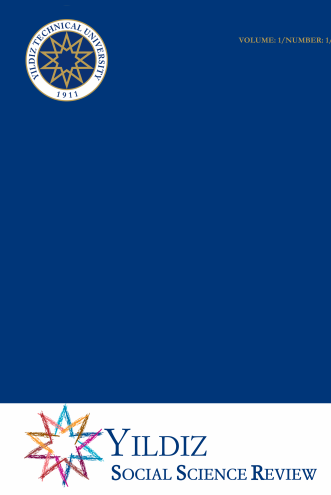GELİŞMEKTE OLAN ÜLKELERDE ORTA GELİR TUZAĞI: LİTERATÜR TARAMASI
Bu çalışma gelişmekte olan ülkelerde orta gelir tuzağıyla ilgili yayımlanmış çalışmaların incelenerek bu çalışmalardan elde edilen bilgilerin sistematik derlenmesi amacıyla gerçekleştirilmiştir. Konuyla ilgili 105 yayına ulaşılmış olup araştırmaya dahil edilme kriterlerine göre 31 yayın çalışma kapsamında incelenmiştir. Orta gelir grubundan yüksek gelir grubuna geçemeyen ülkelerin ortak yapısal özellikleri arasında düşük beşeri sermaye, düşük Ar-Ge yatırımları, yetersiz fiziki ve ileri altyapı yatırımları, yüksek yolsuzluk, yüksek enflasyon, yüksek bağımlılık oranı belirlenmiştir. Gelişmekte olan ülkelerde orta gelir tuzağıyla ilgili çalışmaların sistematik olarak derlenmesi ile gelişmekte olan ülkelerin yüksek gelir grubuna ulaşabilmelerini sağlayacak dinamikler belirlenmiştir. Bu dinamiklerin gelecekte yapılacak çalışmaların çerçevesini oluşturma ve alınabilecek önlemlerin belirlenmesine katkı sağlaması beklenmektedir.
Anahtar Kelimeler:
Orta Gelir Tuzağı, Gelişmekte olan Ülkeler, Büyüme
___
- A.Arias, M., & Wen, Y. (2016). Relative İncome Traps. Federal Reserve Bank of St. Louıs Review, Vol.98, Issue.1, 41-60.A.Hartwell, C. (2018). Old Wine and New Bottles: A Critical Appraisal of the Middle İncome Trap in BRICS Countries. Russian Journal of Economics,4, 133-154.Abiad, A., Debuque-Gonzales, M., & Sy, A. L. (2018). The Evolution and İmpact of İnfrastructure in Middle İncome Countries:Anything Special? Emerging Markets Finance and Trade, Vol.54, Issue.6, 1239-1263.Bien, Y.-H., Su, Y. M., Wang, Y.-C., Chang, C.-H., & Ming-Ru, Z. (2016). Study on Dynamic Factors Striding Across the Middle İncome Trap-Transnational Empirical Analysis Based on Quartile Regression. Journal of Statistics and Management Systems,19:1, 107-118.Bozkurt, E., Sevinç, H., & Çakmak, E. (Nisan 2016). Orta Gelir Tuzağı:Üst Orta Gelirli Ülkeler Üzerine Panel Veri Analizi. Ege Akademik Bakış, Cilt.16, Sayı.2, 379-394.Doner, R. F., & Schneider, B. R. (2016). The Middle İncome Trap:More Politics than Economics, Vol.68, Issue.4. World Politics, 608-644.Estrada, G., Han, X., Park, D., & Tian, S. (2018). Asia's Middle İncome Challenge: An Overview. Emerging Markets Finance & Trade, Vol.54, Issue.6, 1208-1224.Felipe, J., Kumar, U., & Galope, R. (2017). Middle İncome Transitions:Trap or Myth? Journal of the Asian Pacific Economy,Vol.22, Issue.3., 429-453.Freeman, R. B. (2015). Knowledge, Knowledge.......Knowledge for My Economy. KDI Journal of Economic Policy, 37:2, 1-21.Gill, İ., & Kharas, H. (2009). Gravity and Friction in Growing East Asia . Oxford Review of Economic Policy, Vol.25, Number.2, 190-204.Ha, J., & Lee, S. H. (2016). Demographic Dividend and Asia's Economic Convergence Towards the US. The Journal of the Economics Ageing, Vol.8, 28-41.Ha, J., & Lee, S. H. (2018). Population Aging and the Possibility of a Middle İncome Trap in Asia. Emerging Markets Finance and Trade, Vol.54, İssue.6, 1225-1238.Han, X., & Wei, S. J. (2017). Re-Examining the Middle İncome Trap Hypothesis(MITH): What to Reject and What to Revive? Journal of İnternational Money and Finance, Vol.73., 41-61.Im, F. G., & Rosenblatt, D. (2013). Middle İncome Traps. Policy Research Working Paper, 6594, 1-40.Kim, J., & Park, J. (2018). The Role of Total Factor Productivity Growth in Middle İncome Countries. Emerging Markets Finance and Trade, Vol.54, Issue.6, 1264-1284.Lavopa, A., & Szirmai, A. (2018). Structural Modernisation and Development Traps:An Empirical Approach. World Development,112, 59-73.Lubis, R. F., & Saputra, P. M. (2015). The Middle İncome Trap: İs There a Way out for Asian Countries? Journal of İndonesian Economy and Business, Vol.30, Number 3, 273-287.Medina, L. R. (June 2018). Reviewed İnnovation and İnclusion in Latin America:Strategies to Avoid the Middle İncome Trap. Latin America Policy, Vol:9,Issue:1, 169-175.Mueller, A. P. (2018). The Middle İncome Trap in the Perspective of the Austrian Capital Theory. İnterdisciplinary Journal of Philosophy, Law and Economics, 1-26.Otsuka, K., Higuchi, Y., & Sorobe, T. (2017). Middle İncome Traps in East Asia: An İnquiry into Causes for Slowdown in İncome Growth. China Economic Review, Vol.46., 3-16.Öztürk, A. (2016). Examining the Economic Growth and the Middle İncome Trap from the Perspective of the Middle Class. İnternational Business Review, Vol.25, Issue.3, 726-738.Paus, E. (2009). The Rise of China: İmplications for Latin American Development. Development Policy Review, 27:4, 419-456.Radosevic, S., & Yoruk, E. (2018). Technology Upgrading of Middle İncome Economies:A New Approach and Results. Technological Forecasting & Social Change,129, 56-75.Raiser, M., Wes, M., & Yılmaz, A. (2016). Beyond Convergence:Poland and Turkey en Route to High İncome. Central Bank Review, Vol.16, 7-17.Shelburne, R. C. (2016). Long Run Economic Growth: Stagnations, Explosions and the Middle İncome Trap. Global Economy Journal, Vol.16, Issue.3, 433-458.Su, D., & Yao, Y. (2017). Manufacturing As The Key Engine of Economic Growth for Middle İncome Economies. Journal of the Asia Pacific Economy, Vol.22, Issue.1, 47-70.Tuğcu, C. T. (2015). How to Escape the Middle İncome Trap: İnternational Evidence from a Binary Dependent Variable Model. Theoretical and Applied Economics, Vol.XXII, No.1, 49-56.Yılmaz, G. (2016). Labor Productivity in the Middle İncome Trap and the Graduated Countries. Central Bank Review, Vol.16, Issue.2, 73-83.Yusuf, S. (2017). Middle İncome Countries:Trapped or Merely Slowing. Asian-Pacific Economic Literature, Vol.31, Issue.2, 19-29.Yülek, M. A. (2017). On the Middle İncome Trap, The İndustrialization Process and Appropriate İndustrial Policy. Journal of Industry Competition & Trade, Vol.17, Issue.3, 325-348.Zhou, M. Y., Xiong, W. M., Li, X. Y., & Liao, H. (2018). The Middle İncome Trap and The Coping Strategies From Network-Based Perspectives. Entropy, Vol.20, Issue.10, 1-14.
- A.Hartwell, C. (2018). Old Wine and New Bottles: A Critical Appraisal of the Middle İncome Trap in BRICS Countries. Russian Journal of Economics,4, 133-154.
- Bien, Y.-H., Su, Y. M., Wang, Y.-C., Chang, C.-H., & Ming-Ru, Z. (2016). Study on Dynamic Factors Striding Across the Middle İncome Trap-Transnational Empirical Analysis Based on Quartile Regression. Journal of Statistics and Management Systems,19:1, 107-118.
- ISSN: 2149-4363
- Başlangıç: 2015
- Yayıncı: Yıldız Teknik Üniversitesi
